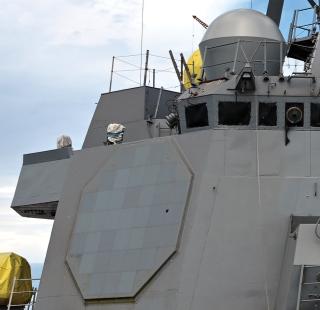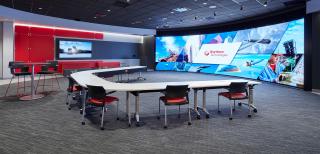Raytheon’s Missiles and Defense business unit is collaborating with shipbuilder Huntington Ingalls Industries (HII) for systems integration for the SPY-6(v) radar on the Navy’s Flight III Arleigh Burke–class guided-missile destroyers (DDGs).
Installation of the 14-foot-square modular radar arrays has been completed on board the first Flight III ship, the future Jack H. Lucas (DDG-125), as the Pascagoula, Mississippi, shipyard readies the ship for sea trials. Raytheon also has delivered the radar arrays to Huntington for the next HII Flight III ship, the future Ted Stevens (DDG-128), and to Bath Iron Works in Maine, which is building the future Louis H. Wilson Jr. (DDG-126).
Raytheon won a 2014 Navy engineering, manufacturing, and development (EMD) contract to develop the SPY-6(v) as the next-generation radar—the “air-missile defense radar”—for DDGs. The Raytheon radar has displaced Lockheed Martin’s SPY-1(v) radar, which is still in service on board some DDGs and Ticonderoga-class cruisers. Lockheed Martin will continue to provide the Aegis combat system software for the Flight IIIs.
Raytheon’s EMD process introduced advanced technologies, such as gallium nitride for the radar’s transmit-receive modules, and an open-architecture design to enable the company to build scalable versions of the system for other ship classes.
Scott Spence, executive director of Raytheon Missiles and Defense Naval Integrated Solutions, says the company introduced a digital engineering process that enables “advanced visualization” for defense systems design that includes the Army’s lower-tier air-and-missile defense sensor. He says that eventually digital engineering will be used for all Raytheon defense systems.
“The SPY-6(v) is a flagship for the use of digital technology,” he says. “We use the digital engineering tools to lay out [the system design] on the factory floor to ensure an efficient method for building the system.”
For the radar design work, the company’s Andover, Massachusetts, Immersive Design Center (IDC) uses advanced software tools such as artificial intelligence, machine learning, and modeling and simulation. The center’s 32-foot-long LED screen provides a three-dimensional environment that reveals potential “hard spots” in the design process, Spence says. The IDC also helped the company configure its 30,000-square-foot Radar Development Facility where the SPY-6(v) is built.
Using the IDC’s capabilities, Spence says, “operators and maintainers can visualize the problem set they’re trying to solve. For example, we can put the layout of a ship into the IDC and see how the radar will integrate aboard the ship in a three-dimensional environment.”
Spence adds that the three-dimensional perspective is particularly important for backfitting the radar onto existing ships. He explains that those spaces, called “as-built,” may differ from how they are shown in original design drawings. Laser measurement tools allow the designers to determine the actual dimensions today. Using the IDC tools, they then can create 3-D models that provide critical insights for installation and systems integration.
The new radar is designed to detect and track long-range airborne and sea-launched antiship and ballistic-missile threats. A SPY-6(v)2 variant will go on board America-class amphibious ships and Nimitz-class aircraft carriers. Newer carriers and Constellation-class frigates will get a (v)3 system, while in-service Flight IIA DDGs will receive a (v)4 variant. In July, Raytheon delivered the first of three SPY-6(v)3 radar arrays to the HII shipyard in Newport News, Virginia, for the USS John F. Kennedy (CVN-79), the second of four Gerald R. Ford–class aircraft carriers.
Raytheon has built IDCs at facilities in Tucson, Arizona; Fullerton, California; McKinney, Texas; Canberra, Australia; and Warsaw, Poland, that enable engineers at all the sites to work collaboratively in real-time. The company is using the IDC in Warsaw for work on the Patriot air-defense system, which the United States is providing to the Polish armed forces.








